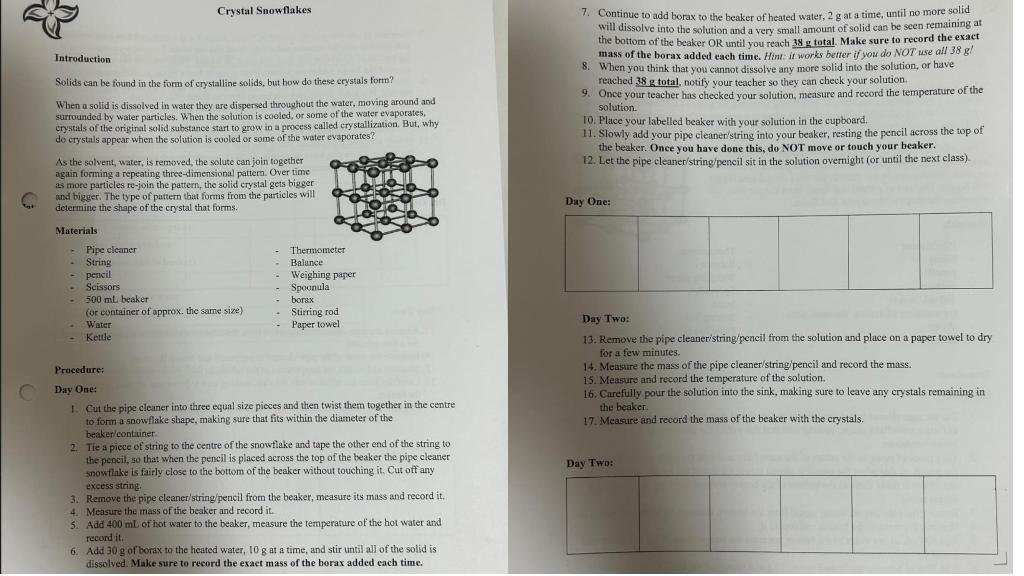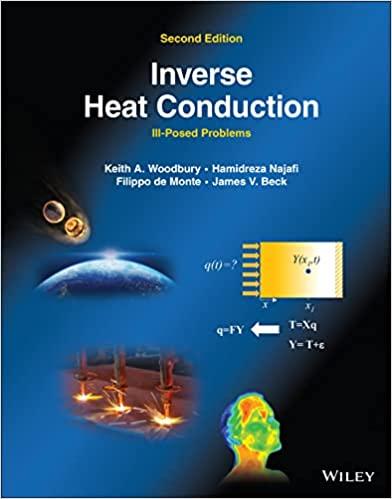Answered step by step
Verified Expert Solution
Question
1 Approved Answer
I need a simple drawing for the procedure following the instructions for Day 1 and Day 2 Crystal Snowflakes 7. Continue to add borax to

I need a simple drawing for the procedure following the instructions for Day 1 and Day 2
Crystal Snowflakes 7. Continue to add borax to the beaker of heated water, 2g at a time, until no more solid will dissolve into the solution and a very small amount of solid can be seen remaining at the bottom of the beaker OR until you reach 38g total. Make sure to record the exact Introduction mass of the borax added each time. Hint it works better if you do NOT use all 38g ! Solids can be found in the form of crystalline solids, but how do these crystals form? 8. When you think that you cannot dissolve any more solid into the solution, or have reached 38 g total, notify your teacher so they can check your solution. When a solid is dissolved in water they are dispersed throughout the water, moving around and surrounded by water particles. When the solution is cooled, or some of the water evaporates, crystals of the original solid substance start to grow in a process called crystallization. But, why do crystals appear when the solution is cooled or some of the water evaporates? 9. Once your teacher has checked your solution, measure and record the temperature of the solution. 10. Place your labelled beaker with your solution in the cupboard. 11. Slowly add your pipe cleaner'string into your beaker, resting the pencil across the top of the beaker. Once you have done this, do NOT move or touch your beaker. As the solvent, water, is removed, the solute can join together 12. Let the pipe cleaner/string/pencil sit in the solution overnight (or until the next class). again forming a repeating three-dimensional pattem. Over time as more particles re-join the pattern, the solid crystal gets bigger and bigger. The type of pattern that forms from the particles will determine the shape of the crystal that forms. Materials - Pipe cleaner - String - pencil - Scissors - 500mL beaker Day Two: - Water - Paper towel 13. Remove the pipe cleaneristring/pencil from the solution and place on a paper towel to dry for a few minutes. Procedure: 14. Measure the mass of the pipe cleaner/string/pencil and record the mass. Day One: 15. Measure and record the temperature of the solution. 1. Cut the pipe cleaner into three equal size pieces and then twist them together in the centre 16. Curefilly pour the solution into the sink, making sure to leave any crystals remaining in to form a snowflake shape, making sure that fits within the diameter of the the beaker. beakericontuiner. 2. Tie a picce of string to the centre of the snowllake and tape the other end of the string to the pencil, so that when the pencil is placed across the top of the beaker the pipe cleaner snowtlake is fairly close to the bottom of the beaker without touching it. Cut off any excess string. 3. Remove the pipe cleaner/string/pencil from the beaker, measure its mass and record it. 4. Measure the mass of the beaker and record it. 5. Add 400mL of hot water to the beaker, measure the temperature of the hot water and record it. 6. Add 30g of borax to the heated water, 10g at a time, and stir until all of the solid is dissolved. Make sure to record the exact mass of the borax added each time. Crystal Snowflakes 7. Continue to add borax to the beaker of heated water, 2g at a time, until no more solid will dissolve into the solution and a very small amount of solid can be seen remaining at the bottom of the beaker OR until you reach 38g total. Make sure to record the exact Introduction mass of the borax added each time. Hint it works better if you do NOT use all 38g ! Solids can be found in the form of crystalline solids, but how do these crystals form? 8. When you think that you cannot dissolve any more solid into the solution, or have reached 38 g total, notify your teacher so they can check your solution. When a solid is dissolved in water they are dispersed throughout the water, moving around and surrounded by water particles. When the solution is cooled, or some of the water evaporates, crystals of the original solid substance start to grow in a process called crystallization. But, why do crystals appear when the solution is cooled or some of the water evaporates? 9. Once your teacher has checked your solution, measure and record the temperature of the solution. 10. Place your labelled beaker with your solution in the cupboard. 11. Slowly add your pipe cleaner'string into your beaker, resting the pencil across the top of the beaker. Once you have done this, do NOT move or touch your beaker. As the solvent, water, is removed, the solute can join together 12. Let the pipe cleaner/string/pencil sit in the solution overnight (or until the next class). again forming a repeating three-dimensional pattem. Over time as more particles re-join the pattern, the solid crystal gets bigger and bigger. The type of pattern that forms from the particles will determine the shape of the crystal that forms. Materials - Pipe cleaner - String - pencil - Scissors - 500mL beaker Day Two: - Water - Paper towel 13. Remove the pipe cleaneristring/pencil from the solution and place on a paper towel to dry for a few minutes. Procedure: 14. Measure the mass of the pipe cleaner/string/pencil and record the mass. Day One: 15. Measure and record the temperature of the solution. 1. Cut the pipe cleaner into three equal size pieces and then twist them together in the centre 16. Curefilly pour the solution into the sink, making sure to leave any crystals remaining in to form a snowflake shape, making sure that fits within the diameter of the the beaker. beakericontuiner. 2. Tie a picce of string to the centre of the snowllake and tape the other end of the string to the pencil, so that when the pencil is placed across the top of the beaker the pipe cleaner snowtlake is fairly close to the bottom of the beaker without touching it. Cut off any excess string. 3. Remove the pipe cleaner/string/pencil from the beaker, measure its mass and record it. 4. Measure the mass of the beaker and record it. 5. Add 400mL of hot water to the beaker, measure the temperature of the hot water and record it. 6. Add 30g of borax to the heated water, 10g at a time, and stir until all of the solid is dissolved. Make sure to record the exact mass of the borax added each timeStep by Step Solution
There are 3 Steps involved in it
Step: 1

Get Instant Access to Expert-Tailored Solutions
See step-by-step solutions with expert insights and AI powered tools for academic success
Step: 2

Step: 3

Ace Your Homework with AI
Get the answers you need in no time with our AI-driven, step-by-step assistance
Get Started


